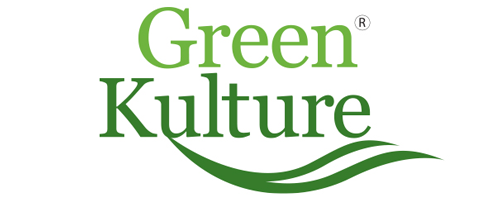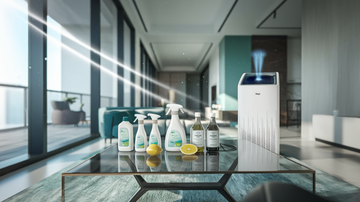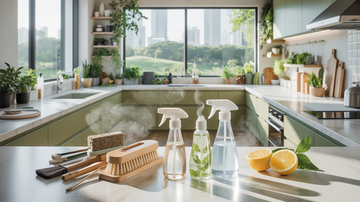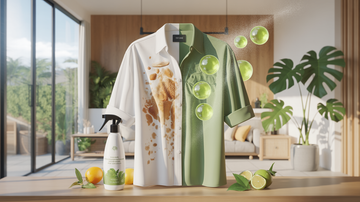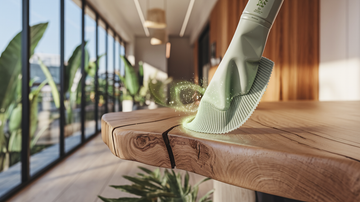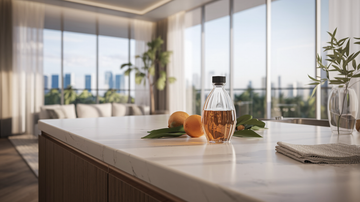Table of Contents
- Understanding VOCs: The Hidden Pollutants in Your Home
- Health Impacts of VOC Exposure
- VOCs in Common Cleaning Products
- Singapore-Specific Considerations
- Assessing Your Home's Air Quality
- Natural Alternatives: A Safer Approach to Cleaning
- Practical Tips for Reducing VOCs in Your Singapore Home
- Green Kulture's Approach to VOC-Free Cleaning
In a bustling urban environment like Singapore, where we spend up to 90% of our time indoors, the quality of our home air becomes critically important to our health. Behind the fresh scent of many conventional cleaning products lurks an invisible threat: Volatile Organic Compounds (VOCs). These chemicals evaporate at room temperature and can silently contaminate your home's air, potentially causing both immediate discomfort and long-term health concerns.
Singapore's unique climate—hot, humid, and with frequent need for air conditioning—creates the perfect storm for VOC accumulation in enclosed spaces. The city's high-density housing further compounds this issue, with limited ventilation in many HDB flats and condominiums.
This article explores how VOCs from everyday cleaning products affect Singaporean homes, the health implications for your family, and natural alternatives that can help you maintain a truly clean and healthy living environment. You'll discover practical steps to reduce your family's exposure to these harmful chemicals without compromising on cleanliness or convenience.
Understanding VOCs: The Hidden Pollutants in Your Home
Volatile Organic Compounds are carbon-containing chemicals that easily evaporate into the air at room temperature. This process, known as off-gassing, means these compounds constantly release from products into your home's air. While some VOCs produce detectable odors (like that \"clean\" smell after mopping), many are completely odorless, making them particularly insidious.
In Singaporean homes, cleaning products represent one of the most significant sources of indoor VOCs. From floor cleaners to bathroom disinfectants, window sprays to furniture polish, these everyday items can contain dozens of volatile compounds. Other common household VOC sources include air fresheners, paint, new furniture, and even some types of flooring.
Singapore's tropical climate creates unique challenges when it comes to VOCs. The high humidity can actually increase the rate at which some VOCs are released from products. Meanwhile, the widespread use of air conditioning in Singaporean homes means windows and doors often remain closed, preventing these chemicals from dissipating. In high-density housing like HDB flats, where ventilation may already be limited, this creates a perfect environment for VOC accumulation.
Health Impacts of VOC Exposure
The health effects of VOC exposure can range from immediately noticeable to subtly cumulative over time. Short-term exposure may trigger eye, nose, and throat irritation, headaches, dizziness, and respiratory difficulties. Some people experience allergic skin reactions, while others report fatigue or difficulty concentrating when VOC levels are high.
More concerning are the potential long-term health impacts of chronic low-level exposure. Scientific research has linked prolonged VOC exposure to respiratory disorders, liver and kidney damage, and central nervous system issues. Some VOCs found in conventional cleaning products are known or suspected carcinogens. These health risks become especially concerning in Singapore's context, where dense urban living means many people spend extended periods in potentially VOC-rich environments.
Certain groups face heightened vulnerability to VOC exposure. Children, with their developing bodies and higher respiratory rates, absorb proportionally more pollutants than adults. Their smaller bodies and developing systems make them particularly susceptible to chemical exposures. Elderly individuals, pregnant women, and those with pre-existing respiratory conditions like asthma or COPD also face greater risks from VOC exposure.
VOCs in Common Cleaning Products
The cleaning aisle of any Singaporean supermarket contains numerous products harboring VOCs. These include:
All-purpose cleaners often contain glycol ethers and terpenes. Glass cleaners frequently include ammonia and methanol. Air fresheners can contain formaldehyde and benzene derivatives. Furniture polish is often high in petroleum distillates, while disinfectant sprays may contain phenols and quaternary ammonium compounds.
The chemical components in these products serve various functions—from dissolving grease to killing bacteria—but many release harmful VOCs in the process. Particularly troubling ingredients include formaldehyde (found in many disinfectants and known to cause respiratory irritation and cancer), benzene (present in some detergents and linked to blood disorders and cancer), perchloroethylene (common in stain removers and classified as a probable carcinogen), and phthalates (found in fragranced products and associated with reproductive issues).
When shopping for cleaning products in Singapore, scrutinize labels for terms like \"Warning,\" \"Flammable,\" or \"Use in well-ventilated area\"—these are indirect indicators of VOC content. Unfortunately, manufacturers aren't required to list all ingredients, making informed choices difficult. Products marketed as \"green\" or \"natural\" may still contain VOCs unless specifically labeled as \"VOC-free\" or \"zero VOCs.\"
Singapore-Specific Considerations
Singapore's unique environmental factors create special challenges when it comes to VOCs in homes. The year-round high humidity (averaging 80-85%) can accelerate the off-gassing of certain VOCs and provide ideal conditions for mold growth, which itself can release microbial VOCs. This combination creates a complex indoor air quality situation distinct from temperate climates.
Singapore's predominantly high-rise living arrangements present ventilation challenges. HDB flats and condominiums, especially those facing busy roads or industrial areas, face a difficult balancing act: open windows to reduce indoor VOCs but potentially let in outdoor pollution, or keep windows closed and risk VOC buildup. Central air conditioning systems, while providing relief from Singapore's heat, can recirculate VOCs throughout the home if not properly maintained with adequate filtration.
On the regulatory front, Singapore has standards for outdoor air quality but fewer specific regulations governing indoor air pollutants in residential settings. While the National Environment Agency (NEA) provides general guidance on maintaining good indoor air quality, specific VOC limitations in consumer products lag behind some international standards.
Assessing Your Home's Air Quality
How can you tell if VOCs are a problem in your Singaporean home? Several warning signs may indicate elevated VOC levels:
Persistent odors, especially \"chemical\" smells that linger after cleaning, are a common indicator. Family members experiencing headaches, irritation, or respiratory symptoms that improve when leaving the home might be reacting to VOCs. New or worsening allergy-like symptoms that don't respond to typical allergy treatments can also signal VOC issues. Watch for visible signs of condensation or dampness that could contribute to higher VOC release rates.
While professional air quality testing provides the most accurate assessment, simple steps can help you evaluate your situation. VOC detection kits are available online and in some Singapore hardware stores. These range from simple color-changing badges to more sophisticated consumer-grade electronic monitors. For a comprehensive assessment, professional testing services in Singapore can provide detailed analysis of your home's air quality, though these services typically start at several hundred dollars.
Natural Alternatives: A Safer Approach to Cleaning
The good news is that effective cleaning doesn't require VOC-laden products. Natural cleaning alternatives offer several advantages beyond just VOC reduction.
Natural cleaning products typically harness the power of plant-derived ingredients and beneficial microorganisms rather than harsh chemicals. Probiotic cleaners, for instance, use beneficial bacteria to break down dirt, grease, and organic matter—effectively cleaning surfaces while helping establish a healthy microbiome in your home. Unlike chemical disinfectants that create a barren surface easily recolonized by harmful bacteria, probiotic cleaners establish beneficial microorganisms that continue working long after application.
Contrary to some misconceptions, natural cleaners can be highly effective. Scientific studies have shown that properly formulated natural cleaners can match or exceed the cleaning performance of conventional products. The key difference is that natural cleaners may work through different mechanisms—biological degradation instead of chemical solvents, for example—and sometimes require slightly different application techniques for optimal results.
Cost has traditionally been a barrier to natural cleaning products, but this landscape is changing rapidly. As more Singaporeans prioritize health and sustainability, brands like Green Kulture are making natural cleaning solutions more affordable and accessible. When considering the total cost—including potential health impacts, environmental effects, and the multi-purpose nature of many natural cleaners—the value proposition becomes even more compelling.
Practical Tips for Reducing VOCs in Your Singapore Home
Beyond switching to natural cleaning products, several strategies can help reduce VOC exposure in your Singapore home:
Ventilation is your first line of defense against VOC buildup. In Singapore's climate, consider using exhaust fans during and after cleaning, even when air conditioning is running. For homes with windows on opposite sides, create cross-ventilation by opening windows strategically during lower pollution periods (typically early morning). Portable air purifiers with activated carbon filters can help remove VOCs from indoor air, providing an additional layer of protection.
When transitioning away from conventional cleaners, start with products used most frequently or in enclosed spaces like bathrooms. Store any remaining conventional cleaning products outside your living space—in an exterior storage area if possible, or at minimum in a well-sealed container in a ventilated utility area. Never mix cleaning products, as this can create dangerous chemical reactions and release additional VOCs.
Beyond cleaning products, consider other VOC sources in your Singapore home. Choose low-VOC or zero-VOC paints for your next renovation project. Allow new furniture to \"off-gas\" in a well-ventilated space before bringing it into regular living areas. Indoor plants like peace lilies, snake plants, and pothos can help absorb some airborne chemicals while adding natural beauty to your space.
Green Kulture's Approach to VOC-Free Cleaning
Green Kulture, a homegrown Singaporean brand, has developed an innovative approach to the VOC challenge. Their cleaning products are crafted using plant-derived probiotic solutions created from fruit and vegetable enzymes. This natural fermentation process produces powerful cleaning agents that effectively tackle dirt and grime without introducing harmful chemicals into your home.
The enzymatic formulations work through a different mechanism than chemical cleaners. Rather than using harsh solvents that dissolve dirt (and release VOCs in the process), the beneficial microorganisms in Green Kulture products consume organic matter, effectively breaking down stains, odors, and residues at the microscopic level. This biological approach continues working long after application, creating increasingly cleaner surfaces over time.
For Singaporean households, Green Kulture's products offer particular advantages. Their non-toxic, child-safe formulations provide peace of mind for families with young children navigating Singapore's space-constrained homes where cleaning products are often stored within reach. The absence of harsh chemicals means no harmful residues on surfaces children might touch or mouth. For those with respiratory sensitivities or allergies—conditions often exacerbated by Singapore's air quality challenges—these VOC-free formulations minimize respiratory triggers.
Green Kulture offers a comprehensive range of natural cleaners for every household need. From all-purpose cleaners for daily use to specialized solutions for kitchens and bathrooms, their product line addresses the full spectrum of cleaning needs while maintaining their commitment to environmental and human health. For those new to natural cleaning, their bundle options provide an economical way to transition multiple cleaning products at once.
For households looking to make the switch to natural cleaning, special promotions frequently make these products even more accessible.
Conclusion: Creating a Truly Healthy Home Environment
The air quality in your Singapore home directly impacts your family's health and wellbeing. While conventional cleaning products might seem to be doing their job, the hidden cost of VOC exposure represents an unnecessary risk—particularly in Singapore's unique environmental context where urban density, climate factors, and housing characteristics can amplify indoor air quality issues.
By understanding the sources and health impacts of VOCs, you've taken the first step toward creating a truly healthy home environment. The transition to natural, VOC-free cleaning products represents a simple yet powerful change that delivers immediate benefits: reduced chemical exposure, improved indoor air quality, and greater peace of mind, especially for households with children or vulnerable family members.
Remember that improving your home's air quality is a journey rather than a destination. Small, consistent changes—starting with your cleaning product choices—can dramatically reduce your family's exposure to harmful chemicals while maintaining the cleanliness standards you expect. Your home should be a sanctuary, not a source of hidden health risks. With the right knowledge and tools, creating a VOC-free environment is within every Singaporean household's reach.
Ready to transform your cleaning routine and create a healthier home environment? Explore
